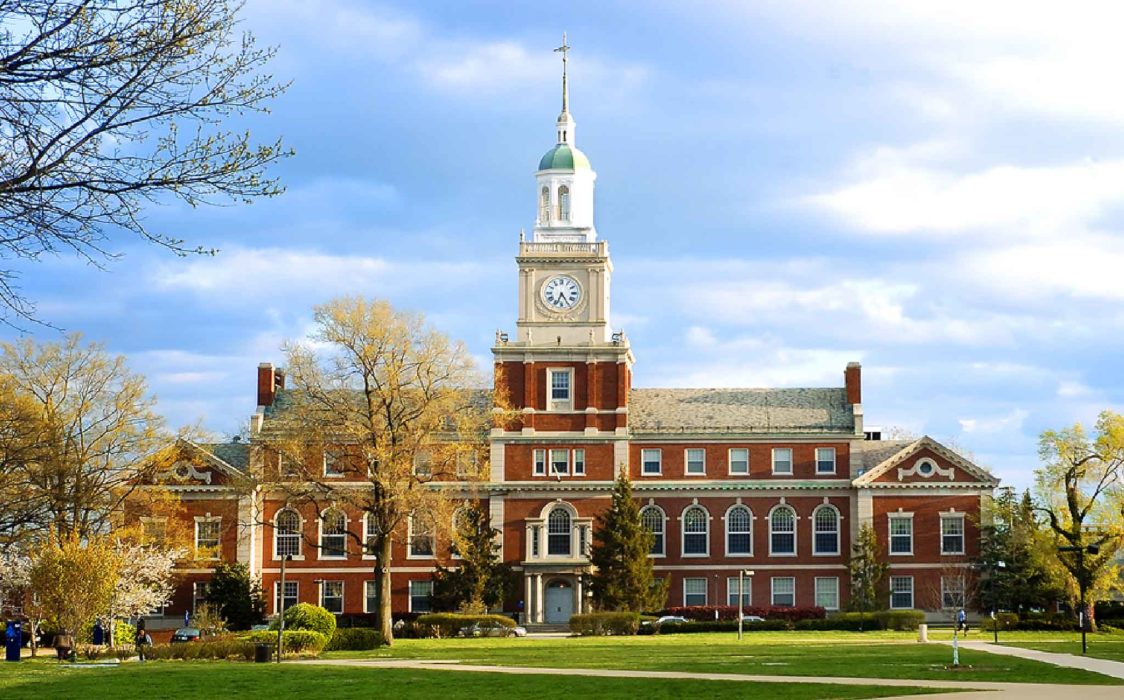AT NOON ON TUESDAY, April 23, ‘Abdu’l-Bahá’s fourth day in Washington, he stood next to Louis Gregory before 1,600 students, faculty, and guests of Howard University, crammed into Howard’s Rankin Chapel. Stained timber arches stretched across the space, resting on hammer beams at the walls and supporting a dark wooden roof. The band played as he entered, and the audience rose in applause.
By 1912 Howard was the nation’s leading black university, having been founded in 1866 to educate newly-emancipated slaves. The overflowing crowd in Rankin Chapel that afternoon was the first predominantly black audience ‘Abdu’l-Bahá would address in America, and the first of two such meetings that Louis Gregory had arranged for that day.
Reverend Wilbur Patterson Thirkield, Howard’s eighth President, introduced ‘Abdu’l-Bahá. “This was a most notable occasion,” wrote Joseph Hannen, who was also in the audience, “and here, as everywhere when both white and colored people were present, Abdul-Baha seemed happiest. The address was received with breathless attention by the vast audience, and was followed by a positive ovation and a recall.”
‘Abdu’l-Bahá began by drawing attention to the diversity in the room. “Today I am happy,” he said, “for I see . . . white and black sitting together.” He then proceeded to reject prevailing black and white views about the essentialism of race — the popular belief that a person’s race was central to his or her humanity:
“There are no whites and blacks before God. All colors are one, and that is the color of servitude to God. Scent and color are not important. The heart is important. If the heart is pure, white or black or any color makes no difference.”

Almost twenty years earlier, journalists who covered the World’s Columbian Exposition in Chicago had begun to associate the racial term “black” with evil, darkness, and filth. A story in Frank Leslie’s Popular Monthly, for example, commented on a group of West Africans who populated one of the ethnological exhibits: “Sixty-nine of them are here in all their barbaric ugliness,” the reporter wrote, “blacker than buried midnight and as degraded as the animals which prowl the jungles of their dark land.” Just seven years before, in 1905, thousands of New Yorkers had watched Ota Benga, a thirty-seven-year-old Pygmy of the Mbuti tribe of Zaire, displayed in a cage at the Bronx Zoo with an orangutan. “Is it a man or a monkey?” asked the New York Times.
But during Louis Gregory’s visit to Alexandria in 1910, ‘Abdu’l-Bahá had begun to craft a new language of race — a new set of racial images and metaphors — which consciously contradicted these ingrained, popular Social Darwinist associations.
They took Louis Gregory as their subject. “I liken you,” ‘Abdu’l-Bahá told him, “to the pupil of the eye. You are black and it is black, yet it becomes the focus of light.” “When he went to Stuttgart,” ‘Abdu’l-Bahá wrote of him, “although being of black color, yet he shone as a bright light in the meeting of the friends.” “He will return to America very soon,” he advised an American friend, “and you, the white people, should then honor and welcome this shining colored man in such a way that all the people will be astonished.”
At Howard University, at the Metropolitan African Methodist Episcopal Church that evening, and in his other speeches to mixed-race gatherings in Washington during the next four days, ‘Abdu’l-Bahá deepened and extended this racial language in order to recast racial differences as a source of beauty.
“As I stand here tonight and look upon this assembly” he told one audience, “I am reminded curiously of a beautiful bouquet of violets gathered together in varying colors, dark and light.” “In the vegetable kingdom the colors of multicolored flowers are not the cause of discord. Rather, colors are the cause of the adornment of the garden because a single color has no appeal; but when you observe many-colored flowers, there is charm and display. The world of humanity, too, is like a garden, and humankind are like the many-colored flowers.” “In the clustered jewels of the races may the blacks be as sapphires and rubies and the whites as diamonds and pearls. The composite beauty of humanity will be witnessed in their unity and blending.”

W. E. B. Du Bois characterized this seemingly innocent approach to the race issue as “the calm sweet universalism of Abdul Baha.” But ‘Abdu’l-Bahá harbored no illusions about the systemic crisis that the race problem posed for America’s social fabric. The problem was urgent, and required immediate, systematic intervention.
“Until these prejudices are entirely removed from the people of the world,” he wrote, “the realm of humanity will not find rest. Nay, rather, discord and bloodshed will be increased day by day, and the foundation of the prosperity of the world of man will be destroyed.” “Now is the time for the Americans to take up this matter and unite both the white and colored races. Otherwise, hasten ye towards destruction! Hasten ye toward devastation!” “Indeed, there is a greater danger than only the shedding of blood. It is the destruction of America.”
On the other hand, ‘Abdu’l-Bahá put little faith in the ability of legal and political equality alone to remove underlying race hatred. “You may bring all the physical powers of the earth,” Kate Carew had heard him say, “and try by their means to make a union where all will love each other, where all will have peace — but it will end in failure.” A year later he wrote to Andrew Carnegie, who had given ‘Abdu’l-Bahá a copy of his book, The Gospel of Wealth. “‘Human Solidarity,’” he wrote, “is greater than ‘Equality.’ ‘Equality’ is obtained, more or less, through coercion (or legislation) but ‘Human Solidarity’ is realized through the exercise of free will.”
It was not enough for antagonistic racial groups to be forced together through legislative means: they had to want to unite.
‘Abdu’l-Bahá’s advocacy for social equality, therefore, went beyond the purely economic, political, and moral aspects of the race issue. He neither lined up with any of the popular white positions in the American racial debate, nor accepted the dichotomy between appeasement and political agitation that characterized African American leaders.
Unlike Booker T. Washington and the Social Gospel reformers, who preoccupied themselves with economic development; unlike Du Bois’s focus on political rights and race pride; and unlike other radicals, such as Clarence Darrow, who opposed segregation and social inequality on the grounds that they violated the American ideals of liberty and equality, ‘Abdu’l-Bahá sought to change the emotional posture of white and black Americans toward the race issue and toward each other.






